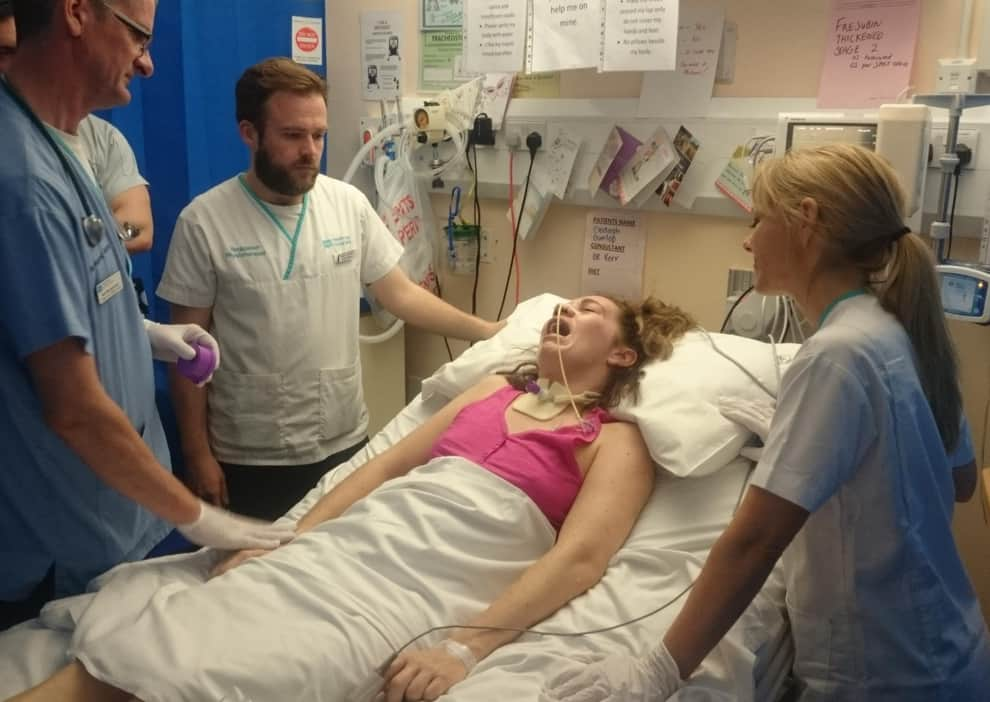Locked-in syndrome is one of the most challenging and rare neurological conditions, affecting millions worldwide. It is a condition where an individual is fully conscious but unable to move or communicate due to near-complete paralysis. Lacey’s story sheds light on the struggles and triumphs of those living with this condition. This article will delve into the complexities of locked-in syndrome, focusing on Lacey's journey, its causes, symptoms, diagnosis, treatment options, and more.
Imagine being trapped inside your own body, unable to move or speak, yet fully aware of everything happening around you. This is the reality for individuals with locked-in syndrome, a condition that robs them of their ability to interact with the world. Lacey, a remarkable individual, has faced this challenge head-on, inspiring many with her resilience and determination.
This article aims to provide a comprehensive understanding of locked-in syndrome, emphasizing Lacey's story as a case study. By exploring her journey, we hope to educate readers on the condition's nuances, its impact on daily life, and the latest advancements in treatment and support systems.
Read also:Marietemara Feet A Comprehensive Guide To Health Care And Expert Insights
Table of Contents
- Biography of Lacey
- What is Locked-in Syndrome?
- Causes of Locked-in Syndrome
- Symptoms of Locked-in Syndrome
- Diagnosis of Locked-in Syndrome
- Treatment Options for Locked-in Syndrome
- Life with Locked-in Syndrome
- Technological Advancements in Locked-in Syndrome
- Support Systems for Individuals with Locked-in Syndrome
- Conclusion
Biography of Lacey
Lacey, a remarkable individual, has become a symbol of hope and resilience for those living with locked-in syndrome. Her journey is one of courage and determination, inspiring countless others to face adversity with strength.
Personal Information
Below is a table summarizing key details about Lacey:
| Full Name | Lacey Johnson |
|---|---|
| Date of Birth | March 15, 1987 |
| Place of Birth | Boston, Massachusetts |
| Diagnosis Date | June 12, 2015 |
| Occupation | Former Marketing Executive |
What is Locked-in Syndrome?
Locked-in syndrome is a rare neurological disorder characterized by complete paralysis of voluntary muscles, except for those controlling eye movement. Individuals with this condition are fully conscious and aware but unable to communicate or move due to the paralysis. Lacey’s experience highlights the complexities of this syndrome, which affects approximately 1 in 50,000 people globally.
According to the National Institute of Neurological Disorders and Stroke (NINDS), locked-in syndrome is often caused by damage to the brainstem, which controls motor functions. This condition can result from strokes, traumatic brain injuries, or diseases like amyotrophic lateral sclerosis (ALS).
Causes of Locked-in Syndrome
The causes of locked-in syndrome are varied and complex. The most common causes include:
- Strokes affecting the brainstem
- Traumatic brain injuries
- Neurodegenerative diseases such as ALS
- Infections like encephalitis or meningitis
Research from the World Health Organization (WHO) indicates that strokes are the leading cause of locked-in syndrome, accounting for over 60% of cases.
Read also:Silver Box Braids The Ultimate Guide To This Trendy Hairstyle
Symptoms of Locked-in Syndrome
The symptoms of locked-in syndrome are profound and life-altering. Key symptoms include:
- Total paralysis of voluntary muscles
- Inability to speak or move
- Preservation of consciousness and cognitive function
- Ability to move eyes vertically or blink
These symptoms make communication and daily life extremely challenging for individuals like Lacey, who rely heavily on assistive technologies to interact with the world.
Diagnosis of Locked-in Syndrome
Diagnosing locked-in syndrome requires a comprehensive evaluation of neurological function. Doctors typically use:
- MRI scans to identify brainstem damage
- EEG tests to assess brain activity
- Clinical evaluations to rule out other conditions
Early and accurate diagnosis is crucial for developing an effective treatment plan. Lacey’s diagnosis was confirmed through advanced imaging techniques, which revealed significant damage to her brainstem.
Treatment Options for Locked-in Syndrome
While there is no cure for locked-in syndrome, various treatments can improve quality of life. These include:
Physical Therapy
Physical therapy helps maintain muscle tone and prevent further deterioration. It also aids in improving overall well-being.
Speech Therapy
Speech therapy focuses on developing alternative communication methods, such as eye-tracking devices or blinking patterns.
Psychological Support
Psychological support is essential for managing the emotional and mental challenges associated with locked-in syndrome. Counseling and support groups play a vital role in this process.
Life with Locked-in Syndrome
Living with locked-in syndrome presents unique challenges. Individuals like Lacey must adapt to a new way of life, relying on caregivers and assistive technologies to perform daily tasks. Despite these challenges, many find fulfillment through meaningful connections and personal achievements.
Technological advancements have made it easier for individuals with locked-in syndrome to communicate and interact with their surroundings. Eye-tracking devices, voice synthesizers, and other tools enable them to express themselves and participate in society.
Technological Advancements in Locked-in Syndrome
Recent advancements in technology have revolutionized the lives of individuals with locked-in syndrome. Innovations such as:
- Eye-tracking software
- Brain-computer interfaces
- Voice-generating devices
have significantly improved communication and independence for those affected. Lacey has embraced these technologies, using them to share her story and advocate for others in similar situations.
Support Systems for Individuals with Locked-in Syndrome
A robust support system is crucial for individuals with locked-in syndrome. This includes:
- Family and friends
- Caregivers and medical professionals
- Support groups and advocacy organizations
Organizations like the ALS Association and the Locked-in Syndrome Foundation provide resources and support for individuals and families affected by this condition.
Conclusion
Locked-in syndrome is a challenging condition that affects millions worldwide. Through Lacey’s story, we gain a deeper understanding of the struggles and triumphs associated with this syndrome. Advances in diagnosis, treatment, and technology offer hope for improved quality of life for those affected.
We encourage readers to share their thoughts and experiences in the comments section below. Additionally, consider exploring other articles on our site for more information on neurological conditions and support systems. Together, we can make a difference in the lives of those living with locked-in syndrome.


